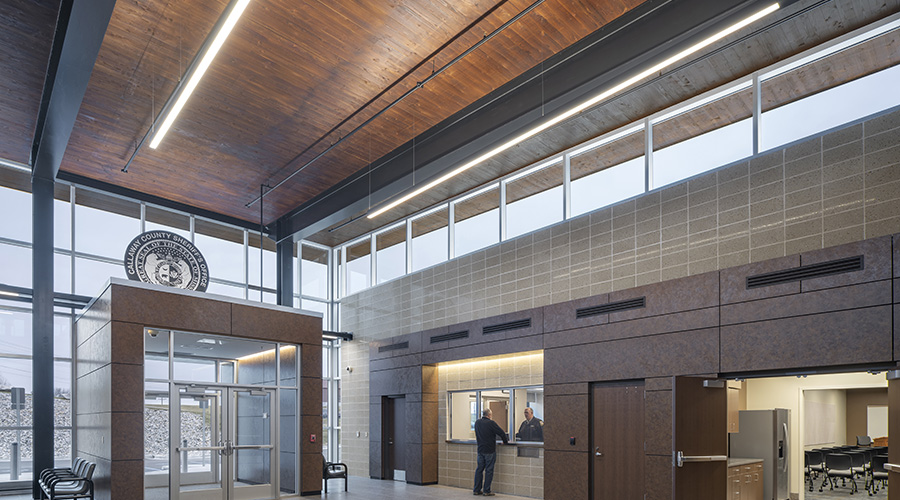Changing Face of School Security
Increased concerns about threats from inside and outside of K-12 school walls prompt officials to review security planning and preventive technologies
Keeping schools safe is a challenging business. Now more than ever, administrators, facility executives and security managers face the task of balancing multiple agendas; weighing real and perceived threats and finding reasonable ways to address both; and making schools safe without making them prisons — all within budget. In addition, new threats have emerged, adding complexity to planning for school security and making it all the more crucial to set effective priorities.
“School officials must be prepared to address all threats on the wide continuum of potential crime and violence that might cross the school house doors,” says Ken Trump, president, National School Safety and Security Services.
Student Threats
Most security issues involve students: drugs, gangs, fighting and theft. Some observers have reported increases in the number of behavioral or disruption issues and increases in the number of incidents involving very young children. Schools also face a wide range of threats involving people from the outside, including kidnappings and altercations between parents and teachers.
Some of these threats have existed for years. What complicates security today is the new issues that have appeared.
Not surprisingly, the much-publicized threat of disaffected students bringing weapons to school looms especially large.
“After Columbine, the biggest concern on most people’s minds is a recurrence of that kind of event,” says Sean Ahrens, senior security consultant, Schirmer Engineering. While national panic over the headline-grabbing rash of school shootings of a few years ago has subsided, these incidents continue to occur frequently enough to warrant serious consideration in any school.
The events of Sept. 11 have also left their mark on schools across the country and especially in major cities. Before the terrorist attacks, few school administrators would have had much concern about their facilities’ susceptibility to a major blast or chemical attack. That has changed, says Robert Cizmadia, vice president, global security services, Gage-Babcock & Associates, Inc. “We have become more aggressive in re-examining our school safeguarding practices and response contingencies.”
Establishing Priorities
One of the key challenges facility executives face is deciding which of the many potential security threats they should attempt to protect their facilities against. A comprehensive plan should begin with a thorough risk assessment that looks at the specific issues that are most pressing for each individual facility.
Key factors in a school’s security profile will include students’ ages, the location of the school and the characteristics of the surrounding community.
“You need to identify the most recurring and egregious issues,” says Tom Bello, senior security consultant with SAKO and Associates, a subsidiary of RJA. “Look at crime statistics. What is happening around the school? What may be happening at the bus stop or as kids are traveling? How about the cyber-safety of students? Or information security at the institution as a whole? There is a lot to consider.”
Each school will have its own set of priorities. Gang problems that plague one school, for instance, may be dwarfed in another by an entirely different set of issues.
It’s important to recognize that security is an issue even in supposedly safe communities. “Threats to school safety cross all boundaries, i.e., urban, suburban and rural,” Trump says. “While large urban districts may have more incidents than some suburban communities, I have also found many urban schools have better security measures and emergency plans in place than their counterparts in suburban and rural areas. Schools cannot afford to hold the, ‘It can’t happen here,’ mentality due to their location in suburban and rural areas.”
A needs assessment can provide critical information about what measures a school should implement; but setting priorities involves more than reviewing crime statistics and incident reports. Increasingly, school administrators are under pressure from parents and others to address perceived security threats — regardless of how likely they are to occur or how feasible it is to prevent them. For the school facility executive, that just comes with the territory.
“It is important to remember that protecting the image of the school is one of the primary goals of security,” says Ahrens. “That doesn’t mean that you implement security measures that are not necessary. It just means that you keep in mind that creating an environment in which people feel safe is one of the goals.”
Terrorist Threats
Terrorism provides a prime example of the kind of threat that demands a balanced mixture of real actions and steps to assuage fears. Physically terror-proofing schools using major technological or physical changes is, for the average school, neither economically feasible nor warranted by the real threat terrorism presents. Nevertheless, many districts have begun examining other ways to become more responsive to the threat of terrorism — and to reassure constituents that they are taking the threat seriously. In particular, facility executives are examining procedural issues related to the management of a heightened terrorist threat — communication with parents, for example, and the circumstances under which students would be sent home as opposed to held at the school.
In addition, school officials are looking at the possibility that their facilities might be used as community safe havens in the event of a terrorist attack.
A Comprehensive Approach
Experts agree that a sound school security plan, in addition to being guided by the findings of a risk assessment, incorporates three basic elements: the school’s physical characteristics, security technology, and safety- and security-related policies and procedures.
The design and layout of the building itself can determine the kinds of measures that should be taken to ensure security. The planning process should examine such questions as:
- What are the school’s access points?
- Is the main entryway visible from the office?
- How close can a vehicle get to the building?
- Are there long hallways or blind corners?
Issues related to these questions have become priorities in the design of new schools. For existing buildings, school officials are finding creative ways to maximize the protection afforded by structural characteristics. Landscaping can enhance or impede visibility. Relocating administrative offices so that they are near the school’s entrances can help control who comes and goes.
Nearly any school faces security challenges that cannot be met through structural solutions alone. Technology plays an important role in a security plan. Growing numbers of schools now employ measures like metal detectors, CCTV, access control systems and graffiti-resistant materials. Although these technologies are not new — the basic options available to schools seeking security solutions remain similar to those available five or more years ago — they are becoming more effective and less expensive.
An important rule of thumb about technology is to remember that it can be useless if it is applied indiscriminately. Prior to settling on specific security technology, experts say school officials should address three questions:
- What problem or potential problem is the equipment intended to address?
- How will this equipment be used on a day-to-day basis?
- What is the plan for maintenance, repair and upgrade once the equipment is installed?
Above all, however, school decision-makers should bear in mind that while technology can be an important part of a security program, it does not stand by itself.
“We can put all the cameras in the world in a school,” says Ahrens, “but what good is it if there is no one there to operate it or if that person has not been trained in what to do when you see a problem?”
“Technology is not the answer to everything,” says Bello. “Security requires a balanced approach.”
Policies and procedures that frame and support other measures constitute a final yet critical piece of an effective security plan. Questions like the following should be carefully examined and addressed: What do you do when you find a weapon or suspect that a student is carrying one? How do you communicate a threat to staff without creating panic? Under what circumstances is it appropriate to call the local police? When is it safer to send students home than to keep them at school? What is the procedure for dealing with an aggressive parent?
Because of the teamwork and communication it demands, the policies and procedures of a security plan can be the most difficult to implement. But failure to address them can compromise an entire security plan.
With all the complexities that go into security planning, it’s easy to overlook the importance of small things. “Some of it just comes down to common sense,” says Cizmadia. “Lock the door. It’s a simple step, but it does create a more secure environment.”
Emphasis on Integration
Experts emphasize that an integrated planning process — one that involves administrators, teachers, parents, local police liaisons and students themselves — is the most effective way to achieve a security program that truly meets everyone’s needs. This points to a push for increased communication between schools and all their constituents around security-related issues.
“There is better coordination and communication between many schools and local jurisdictions,” says Cizmadia. “There are procedures coming into place at many schools about incidents and interaction with the community and communication with parents. A more proactive approach in that arena is one of the biggest changes we have seen.”
This change is evident in growing collaboration between school districts and police. In-school police liaisons can play a key role in helping students understand and take seriously their own roles in recognizing signs of trouble and acting to prevent incidents. In addition, police support can be helpful in training staff and parents about what to do if and when a serious incident occurs.
“School safety plans should take a balanced, comprehensive approach to school safety consisting of practical security measures, meaningful emergency preparedness planning, close partnerships with public safety agencies and the school community, prevention and intervention programs, positive school climate, and firm, fair, and consistent discipline,” says Trump.
Abigail May is a freelance writer. She was formerly editor of EducationFM.
Survey Finds school threats growing, training lacking
In August, the National Association of School Resources Officers released a report on its third annual national survey of school-based police officers. Its key conclusions: School safety threats from both inside and outside schools are as significant as ever, and training and preparedness have not increased significantly among schools across the United States.
At the same time, many officers report that funding for school security is declining and express concern that it will continue to do so with changes like the Bush Administration’s proposed cuts in the Safe and Drug-Free Schools Program. Other findings include:
- 76 percent of the officers feel that their schools are not adequately prepared to respond to a terrorist attack.
- 55 percent say their school crisis plans are inadequate.
- 71 percent say that teachers, administrators, security personnel and support staff in their schools have not received terrorism-specific training.
- 41 percent say that funding for safety in their schools is decreasing.
- 70 percent report that they have observed an increase in aggressive behavior among elementary school children over the past five years.
Related Topics:












